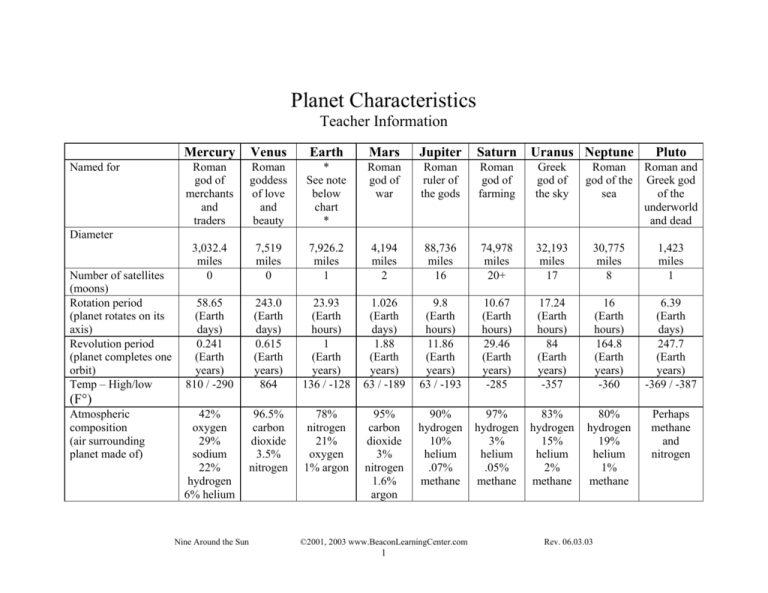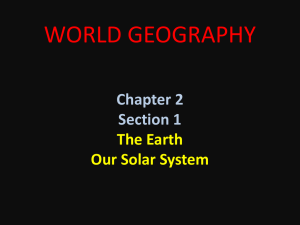Planet Characteristics Chart: Solar System Data
advertisement

Planet Characteristics Teacher Information Named for Mercury Venus Earth Mars Jupiter Saturn Uranus Neptune Pluto Roman god of merchants and traders Roman goddess of love and beauty * See note below chart * Roman god of war Roman ruler of the gods Roman god of farming Greek god of the sky 3,032.4 miles 0 7,519 miles 0 7,926.2 miles 1 4,194 miles 2 88,736 miles 16 74,978 miles 20+ 32,193 miles 17 30,775 miles 8 1,423 miles 1 58.65 (Earth days) 0.241 (Earth years) 810 / -290 243.0 (Earth days) 0.615 (Earth years) 864 23.93 (Earth hours) 1 (Earth years) 136 / -128 1.026 (Earth days) 1.88 (Earth years) 63 / -189 9.8 (Earth hours) 11.86 (Earth years) 63 / -193 10.67 (Earth hours) 29.46 (Earth years) -285 17.24 (Earth hours) 84 (Earth years) -357 16 (Earth hours) 164.8 (Earth years) -360 6.39 (Earth days) 247.7 (Earth years) -369 / -387 42% oxygen 29% sodium 22% hydrogen 6% helium 96.5% carbon dioxide 3.5% nitrogen 78% nitrogen 21% oxygen 1% argon 95% carbon dioxide 3% nitrogen 1.6% argon 90% hydrogen 10% helium .07% methane 80% hydrogen 19% helium 1% methane Perhaps methane and nitrogen Roman Roman and god of the Greek god sea of the underworld and dead Diameter Number of satellites (moons) Rotation period (planet rotates on its axis) Revolution period (planet completes one orbit) Temp – High/low (F°) Atmospheric composition (air surrounding planet made of) Nine Around the Sun ©2001, 2003 www.BeaconLearningCenter.com 1 97% 83% hydrogen hydrogen 3% 15% helium helium .05% 2% methane methane Rev. 06.03.03 Number of rings Gravitational pull (measured in G forces) Mean distance from the sun (AU is an Astronomical Unit and is equal to 93 million miles.) Composition (planet made of) Sequential order from the sun. Order by size (largest to smallest) Mercury Venus Earth Mars Jupiter Saturn Uranus Neptune Pluto 0 0 0 0 1 faint 9 5 Not known 0.38 0.91 1 0.38 2.54 100,000+ (grouped into 3 groups) 0.93 0.8 1.2 Not known 36 million miles (0.387 AU) 67.24 million miles (0.723 AU) 92.9 million miles (1 AU) 141.71 million miles (1.524 AU) 483.88 million miles (5.203 AU) 887.14 million miles (9.539 AU) 1,783.98 million miles (19.18AU) 2,796.46 million miles (30.06 AU) 3,666 million miles (39.53 AU) Mostly rock and metal Mostly rock and metal Mostly rock and metal Mostly rock and metal #2 #3 #4 Gases: mostly hydrogen and helium #6 Gases: mostly hydrogen and helium #7 Gases: mostly hydrogen and helium #8 Not known #1 Gases: mostly hydrogen and helium #5 8 6 3 4 Largest 5 7 1 Source: Microsoft Encarta Encyclopedia 2 #9 Smallest 9 * Earth is the only planet whose English name does not derive from Greek/Roman mythology. The name derives from Old English and Germanic. There are, of course, hundreds of other names for the planet in other languages. In Roman Mythology, the goddess of the Earth was Tellus - the fertile soil (Greek: Gaia, terra mater - Mother Earth). Source: The Nine Planets, http://www.seds.org/billa/tnp/earth.html Nine Around the Sun ©2001, 2003 www.BeaconLearningCenter.com 2 Rev. 06.03.03 Planet Classification Teacher Information The nine bodies conventionally referred to as planets are often further classified in several ways: • by composition: o terrestrial or rocky planets: Mercury, Venus, Earth, and Mars: o jovian or gas planets: Jupiter, Saturn, Uranus, and Neptune: o • The gas planets are composed primarily of hydrogen and helium and generally have low densities, rapid rotation, deep atmospheres, rings and lots of satellites. Pluto. by size: o small planets: Mercury, Venus, Earth, Mars and Pluto. o The small planets have diameters less than 13000 km. giant planets: Jupiter, Saturn, Uranus and Neptune. • The terrestrial planets are composed primarily of rock and metal and have relatively high densities, slow rotation, solid surfaces, no rings and few satellites. The giant planets have diameters greater than 48000 km. o Mercury and Pluto are sometimes referred to as lesser planets (not to be confused with minor planets which is the official term for asteroids). o The giant planets are sometimes also referred to as gas giants. by position relative to the Sun: o inner planets: Mercury, Venus, Earth and Mars. o outer planets: Jupiter, Saturn, Uranus, Neptune and Pluto. Nine Around the Sun ©2001, 2003 www.BeaconLearningCenter.com 3 Rev. 06.03.03 o • by position relative to Earth: o • The asteroid belt between Mars and Jupiter forms the boundary between the inner solar system and the outer solar system. inferior planets: Mercury and Venus. closer to the Sun than Earth. The inferior planets show phases like the Moon's when viewed from Earth. o Earth. o superior planets: Mars thru Pluto. farther from the Sun than Earth. The superior planets always appear full or nearly so. by history: o o o classical planets: Mercury, Venus, Mars, Jupiter, and Saturn. known since prehistorical times visible to the unaided eye modern planets: Uranus, Neptune, Pluto. discovered in modern times visible only with telescopes Earth. Source: The Nine Planets, http://www.seds.org/billa/tnp/overview.html Nine Around the Sun ©2001, 2003 www.BeaconLearningCenter.com 4 Rev. 06.03.03









